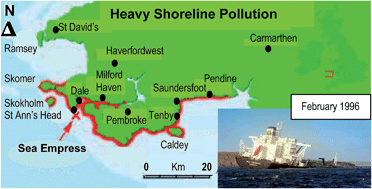Environmental forensics evaluation of sources of sediment hydrocarbon contamination in Milford Haven Waterway†
Abstract
Current and historic petroleum-related activities in Milford Haven Waterway (MHW; Wales, UK) contribute to hydrocarbon contamination of surficial sediments. Three main hydrocarbon components of sediments were analyzed: (1) aliphatic hydrocarbons of predominantly biogenic origin, representing about 5–15% of total hydrocarbons (THC); (2) polycyclic aromatic hydrocarbons (PAHs) from recent petrogenic and mainly older pyrogenic sources, representing about 2–6% of THC; (3) unresolved complex mixture from spill-related and heavily-weathered petrogenic sources, representing as much as 70–85% of THC. Environmental forensics evaluation of the data demonstrate that although 72 000 tonnes (t) crude oil spilled from the Sea Empress in 1996, the Forties blend cargo was not identified in 2010. However, using biomarkers, heavy fuel oil (HFO) from Sea Empress' bunkers (480 t spilled) was detected further upstream and more widely than previously. Iranian crude (100 t) spilled by the El Omar in 1988 and fuel (130 000 t) lost during bombing in 1940 also were tentatively identified. The PAH source ratios demonstrate that the historic pyrogenic PAHs come mainly from biomass and coal combustion. The distribution pattern of PAHs appeared more pyrogenic in 2012 than in 1996, as if recovering from the more petrogenic signature, in places, of the Sea Empress. The heavier PAH distributions were pyrogenic at most stations, and similar to those in sediments from oil terminal berths up to 2006, when dredging operations peaked. Partly as a result of this, in 2007 the concentrations of PAHs peaked throughout the waterway. Apart from effluent, atmospheric and runoff inputs, most of the identified inputs to the surficial sediments are historic. Therefore, likely processes include disturbance by construction (e.g. pile-driving) and dredging of contaminants sequestered in sediments, followed by their wide redistribution via suspended sediment transport.


 Please wait while we load your content...
Please wait while we load your content...